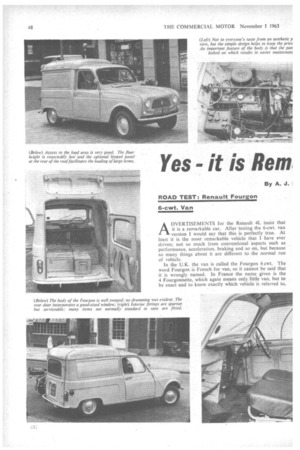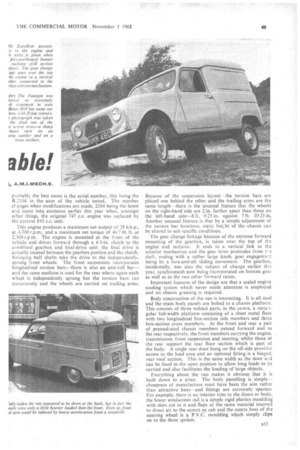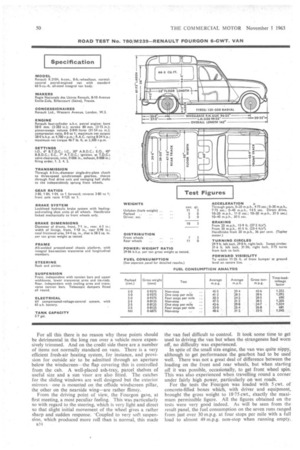Yes it is Rem
Page 50

Page 51

Page 52

Page 53

If you've noticed an error in this article please click here to report it so we can fix it.
Oki
By A. J. I
A.M.I.MECH.E.
ADVERTISEMENTS for the Renault 4L insist that it is a remarkable car. After testing the 6-cwt. van version I would say that this is perfectly true. At least it is the most remarkable vehicle that I have ever driven; not so much from conventional aspects such as performance, acceleration, braking and so on, but because so many things about it are different to the normal run of vehicle.
In the U.K. the van is called the Fourgon 6 cwt. The word Fourgon is French for van, so it cannot be said that it is wrongly named. In France the name given is the 4 Fourgonnette, which again means only little van, but to be exact and to know exactly which vehicle is referred to, probably the best name is the serial number, this being the R.2104 in the tase of the vehicle tested. The number changes when modifications are made, 2104 being the latest and came into existence earlier this year when, amongst other things, the original 747 c.c. engine was replaced by the current 845 c.c. unit.
This engine produces a maximum net output of 28 b.h.p., at 4,700 r.p.rn., and a maximum net torque of 46.7 lb. ft. at 2.300 r.p.m. The engine is mounted at the front of the vehicle and drives forwacd through a 6-3-in. clutch to the combined gearbox and final-drive unit: the final drive is actually located between the gearbox portion and the clutch, Swinging half shafts take the drive to the independentlysprung front wheels. The front suspension incorporates longitudinal torsion bars—there is also an anti-roll bar— and the same medium is used for the rear where again each wheel is independently sprung but the torsion bars run transversely and the wheels are carried on trailing arms. Because of the suspension layout—the torsion bars are piked one behind the other and the trailing arms are the same length—there is the unusual feature that the wheels on the right-hand side are 2 in. fartherapart than those on the left-hand side-8 ft. 0.25 in. against 7 ft. 10-25 in. Another unusual feature is that by a simple adjustment of the torsion bar locations. static. heir ht of the chassis can be altered to suit specific conditions.
The gear change linkage because of the extreme forward mounting of the gearbox, is taken over the top of the engine and radiator. It ends in a vertical link to the selector mechanism and the gear lever protrudes from tne. dash, ending with a rather large knob, gear engageme.c.t being by a fore-and-aft sliding movement. The gearbox, incidentally, was also the subject of chance earlier this year, synchromesh now being incorporated on bottom gear as well as in the two other forward ratios.
Important features of the design are that a sealed engine cooling system which never needs attention is employed and no chassis greasing is required.
Body construction of the van is interesting. It is all steel and the main body panels are bolted to a chassis platform. This consists of three welded parts, in the centre, a recta.-igular full-width platform consisting of a sheet metal floor with two longitudinal box-section side members and three box-section cross members. At the front and rear a pair of pressed-steel chassis members extend forward and to the rear respectively, the front members carrying the engine. transmission, front suspension and steering, whilst those. at the rear support the' real' floor section which is part of the body. A single rear door hung on the off-side provides access to the load area and an optional fitting is a hinged, rear roof section. This is the same width as the'door aP.d can be fixed in the open position to allow long loads to be carried and also facilitates the loading of large Objects.
Everything about the van makes it obvious that it is built down to a price. The body panelling is simple— cheapness of manufacture must have been the aim 'rather than attractive lines---and fittings are extremely spartan. For example, there is no interior trim to the doors or body, the lower windscreen rail is a simple rigid plastics moulding with slots cut in it and flaps of the same material inserted to direct air to the screen or cab and the centre boss of the steering wheel is, a P.V.C. moulding which simply clips on to the three spokes. For all this there is no reason why these points should be detrimental in the long run over a vehicle more expensively trimmed. And on the credit side there are a number of items not normally standard on vans. There is a very efficient fresh-air heating system, for instance, and provision for outside air to be admitted through an aperture below the windscreen-the flap covering this is controlled from the cab. A well-placed ash-tray, parcel shelves of useful size and a sun visor are also fitted. The catches for the sliding windows are well designed but the exterior mirrors one is mounted on the offside windscreen pillar, the other on the nearside wing-are rather flimsy.
From the driving point of view, the Foul-gall gave, at first meeting, a most peculiar feeling. This was particularly so with regard to the steering, which is very light and direct so that slight initial movement of the wheel gives a rather sharp and sudden response. Coupled to very soft suspension, which produced more roll than is normal, this made
the van feel difficult to control. It took some time to get used to driving the van but when the strangeness had worn off, no difficulty was experienced. In spite of the small size engine, the van was quite nippy, although to get performance the gearbox had to be used well. There was not a great deal of difference between the loading on the front and rear wheels, but when starting off it was possible, occasionally, to get front wheel spin. This was also experienced when travelling round a corner under fairly high power, particularly on wet roads.
For the tests the Fourgon was loaded with 5 cwt. of concrete-filled boxes which, with driver and equipment, brought the gross weight to 18.75 cwt., exactly the maximum permissible figure. All the figures obtained on the tests were very good indeed. As will be seen from the result panel, the fuel consumption on the seven runs ranged from just over 30 m.p.g. at four stops per mile with a full load to almost 49 -m.p.g. non-stop when running empty.
On the runs with stops the average speed quoted is based on the time when the vehicle was actually running and excludes the stops, which were of 15 seconds duration. It is reasonable to say that for normal delivery work a consumption of between 33 and 38 m.p.g. should be obtained.
It will be noted that no high-speed fuel consumption run was made; this was due to a number of factors, the main one being that work on M1 motorway would have made figures unreliable. But whilst on the motorway the maximum speeds in the three gears were checked these were found to be 29 m.p.h. in bottom, 49 m.p.h. in second and 72 m.p.h. in .top. The speedometer accuracy was also checked and this instrument was found to read just over 1 per cent fast at 30 m.p.h. and 5 per cent fast at 60 m.p.h.
The figures for acceleration were very good, on the tests through the gears, front wheel-spin (slight) being experienced when starting off. Through-the-gear times were also good and there was a good pull-away from 10 m.p.h. in top gear, which speaks well for the flexibility of the small engine. Braking performance was checked on the same strip of level road as used for the acceleration runs and the figures obtained here were quite acceptable. The van was completely stable on all the maximum-pressure stops and maximum deceleration figures obtained using a Tapley meter were 77 per cent from 20 m.p.h. and 62 per cent from 30 m.p.h. The handbrake was found to be very effective.
Bison Hill, near Dunstable, Beds, was used to assess hillclimbing performance of the Fourgon. A maximum power ascent of the 0-75-mile-long hill was made in the good time of 2 min. 54 sec. Lowest gear used was second. this being engaged for 1 min. 5 sec. and the minimum speed during the climb was 21 m.p.h. Average gradient of Bison is 1 in 10.5 and the maximum is 1 in 6.5 on one short stretch. On this steepest part of the hill, stop and restart tests were made. No trouble was experienced in starting off in bottom gear when facing up the hill and in reverse when facing down the hill, and the handbrake held the van comfortably.
A run down the hill was made to assess brake fade characteristics. The descent was made in neutral with the brakes applied to keep the speed at 20 m.p.h. until near the bottom where the gradient flattens out; here top gear was engaged and with full throttle applied, the brakes kept on to restrict the speed to the same figure. Total time for the descent was 2 min. 49 sec. with 41 sec. spent in top gear, and a maximum pressure stop at the bottom produced a Tapley-meter reading of 70 per cent. This was only 7 per cent less than on the earlier brakes tests from 20 m.p.h. arid showed that there should be no problem with fade.
The Four4on was originally developed by Renault as a vehicle for use in the country districts of France. It is for this reason, no doubt, that it was made simple and cheap and it was designed to operate over rough ground as well as normal roads. To assess the van's ability in off-the-road conditions, a piece of ground on Bison Hill was used. I would not have taken any other van that I have tested there as it is extremely rough with deeply-rutted tracks and very lumpy grassed areas. The load was removed for these tests because of the hazard there would have been from the boxes flying around the interior. Some time was spent driving the Fourgon in all directions around the area at relatively fast speeds; up, down and across the rutted tracks, over the grass and so on.
Although this was extremely rough treatment for any vehicle, even those designed for this type of duty, the Fourgon took it all in its stride and showed no distress at all. The most severe test consisted of coming down a track and making a fairly sharp left-hand turn at the bottom. A number of these runs were made at increasing speeds and, on the final one, both nearside wheels came
clear of the ground. Considering the amount of wheel movement possible with the design of suspension, this was quite a feat. Maurice Rowe, who took the photographs of the test, managed to capture the van in this position. Immediately afterwards he ran! I don't blame him, for he was standing right in the path of the van.
Circumstances prevented maintenance tests being carried out, but as accessibility to the engine, gearbox and final drive units is very good by reason of the forward hinged bonnet and front grille section,, no trouble should be experienced in routine maintenance or for that matter, minor overhauls.
As tested, the Renault Fourgon is priced at £425, optional extras fitted being a passenger's seat and the hinged rear roof section which cost £9 and £12 respectively.




































































































